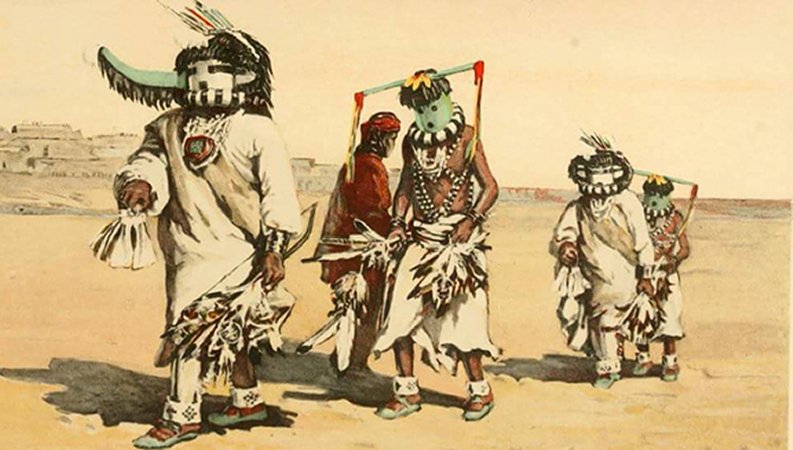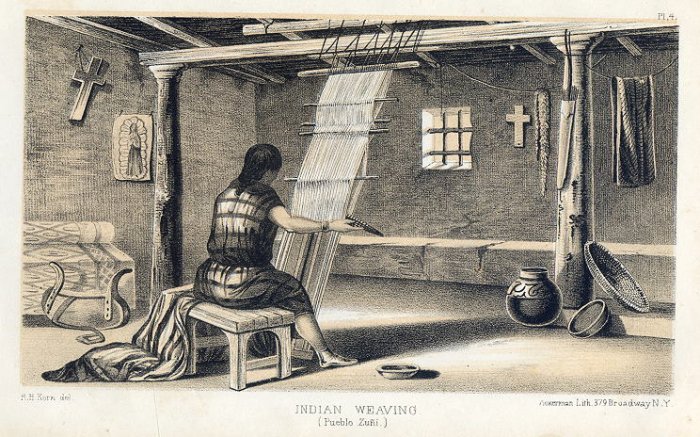Zuni Indians Bravely Fought For Their Ancient Culture, Traditions And Respect For Their Ancestors
Thalia Lightbringer - AncientPages.com - The Zuni people made beautiful things from silver and had a rich cultural tradition, but were primarily farmers. How then did these Pueblo people get mixed up with the Spanish legend of golden cities?
Their story is an interesting one, since they are one of the few tribes who managed to keep their way of life intact. What is the truth about these unique people, and how did they maintain their culture in spite of pressure from the Spanish invaders?
Zuni Rain Priests and Warriors by Internet Archive Book Images, Public Domain
Who Are The Zuni?
The Zuni are one of the Western Pueblo tribes (along with the Hopi). They are primarily based in western New Mexico near the Arizona border. They have lived in this area for thousands of years. The Zuni and Hopi both resisted the Spanish attempts to integrate them and held on to their culture and traditions to a much greater extent than the other North American tribes.
Their language is unique as well. Though the Zuni preserved their culture and language, the words we use to refer to them come from the Spanish language. "Pueblo" is Spanish for "town," and "Zuni" is what the Spanish called this tribe, though the meaning of the word is uncertain. The Zuni called themselves "A:shiwi" (Shi’wi), meaning “the flesh.”
For more about their language and an intriguing theory that Buddhist monks from Japan may have integrated with the Zuni, see: Mysterious Zuni Indians And Japanese People May Be Related – Did Buddhist Monks Reach North America In 1350?
Zuni Silver Inlaid Brooch, 1890s; By Anagoria, Credit: Wikipedia
The Zuni traditions say that they came from the area of the Grand Canyon they called "Chimik’yana’kya dey’a" (Ribbon Falls on Bright Angel Creek), which comes from the north rim wall of the Grand Canyon and flows to the Colorado River.
Before that, Zuni mythology states that they came from somewhere underground. There they lived in four great caverns they called the "Four Wombs of the World." When it became too crowded and miserable there, the people begged for a change. Then the Sun-Father, Holder of the Paths of Life, made two new humans from his own being. These two left the caverns to become the first ancestors of the Zuni people.
Zuni Culture And Traditions
The Zuni have a matrilineal society of thirteen clans, respecting the mothers and grandmothers of the tribe. They have strong ties to the land around them and their traditions express this by celebrating the natural forces around them. Their ceremonies are complex and based on belief in the Ancient Ones, a sort of ancestral worship. They may be descendants of the prehistoric Anasazi.
There are six groups with separate priesthoods devoted to the worship of different supernatural entities. One of the most well-known of their ceremonial celebrations is the Shalako Festival in early winter. This festival involves rain dancers in colorful costumes who represent the deities who bring the rains and go throughout the village blessing new homes.
Zuni Fetishes by Internet Archive Book Images, Public Domain
The Zuni are one of the tribes which have a kachina cult. Kachinas are Spirits which the pueblo cultures believed brought rain and fertility. Salt is also such an important substance to the Zuni that they have associated it with a deity.
The Zuni Salt Lake about 60 miles south of the Zuni Pueblo is the home of the deity they call Salt Mother (Ma'lokkyattsik'I) and her husband Turquoise Man. This goddess of salt traveled around the world leaving deposits of salt wherever she rested. She gave salt to the Zuni people and instructed the priests in how to gather it. It is said that these two deities later left the people when they were bothered by people who had followed her from the seashore she used to live by. An arch in the sandstone there is believed by the Zuni to have been created when Salt Mother and Turquoise Man broke through the wall to enter the mesa when they left.
The Zuni express their traditions and stories through their art, considering it a material record which ties the past to the present. They make jewelry and do some interesting fetish carvings and paintings to express their culture and beliefs. In contrast to many other cultures, the men weave cloth and the women make the pottery.
USA, Indian Weaving (Pueblo Zuni), 1853; Source: ancestryimages.com
The Spanish Invasion And Search For Seven Cities Of Cibola
The Zuni first encountered Spanish colonizers in 1539. Fray Marcos de Niza led an expedition to the area of the Zuni pueblos after hearing rumors of wealth to be found there. Estevan, one of de Niza's men, demanded women and turquoise from the Zuni people they found there. The Zuni responded with violence, and de Niza fled. He spread tales of their cities, calling them the "Seven Cities of Cibola" and claiming they were filled with gold and treasure.
In response to this tale of treasure, Francisco Vásquez de Coronado led an expedition back to the Zuni pueblos a year later. Like de Niza, he found no gold, only resistance from the natives, and was infuriated. He didn't even find seven cities! From what we know, the Zuni had six major pueblo towns and no one is sure why de Niza reported seven.
Coronado sent out several scouting parties in search of the elusive riches. None of these expeditions paid off in treasure, but those led by García López de Cárdenas were the first Europeans to view the Grand Canyon. The men who went on this disastrous mission ended up impoverished and discouraged.
Sunrise at Grand Canyon. Credit: Wikipedia
The Zuni continued to fight the Spanish influence and pressure to change their culture and accept Christianity. The people moved to one fortified pueblo. In 1680, the Zuni were part of the Pueblo Rebellion which defeated the Spanish. They remained independent until 1691, when the Spanish took control of the area once more. Even so, the Zuni still fought against the Spanish ideas of civilization. Eventually, the Spanish were forced to make peace with them and the Zuni in New Mexico remain strong in their culture and traditions to this day.
There were never any cities of gold in the pueblo area. Perhaps these tales originated with other tribes wishing to get the Spanish to leave them alone. It has also been suggested that de Niza saw the pueblo villages at a time when the light gave them a golden tint. He was never allowed to get very close and fled immediately after contact with the Zuni.
If the Spanish had not been so greedy for gold, they may have appreciated that they did find another kind of riches, and their expedition might not have left them in poverty. If they had approached the Zuni with the intention of peaceful trade, they may have been able to at least come back with some beautiful silver jewelry and tales of a marvelous culture living in an awe-inspiring landscape.
Updated on November 9, 2024
Written by – Thalia Lightbringer – AncientPages.com Staff Writer
Copyright © AncientPages.com All rights reserved. This material may not be published, broadcast, rewritten or redistributed in whole or part without the express written permission of AncientPages.com
Expand for referencesNative American Mythology A to Z by Patricia Ann Lynch; 2004
Report of an Expedition down the Zuni and Colorado Rivers,; 1853
Annual report of the Bureau of American Ethnology to the Secretary of the Smithsonian Institution; Smithsonian Institution. Bureau of American Ethnology; 1895; Washington: U. S. Govt. Print. Off.
Zuñi fetiches by Frank Hamilton Cushing; 1883; Washington: U.S. Govt. Print. Off.
More From Ancient Pages
-
 Ancient Maya Destroyed Their Environment 2,000 Years Ago – Effects Are Still Visible Today
Civilizations | Sep 9, 2015
Ancient Maya Destroyed Their Environment 2,000 Years Ago – Effects Are Still Visible Today
Civilizations | Sep 9, 2015 -
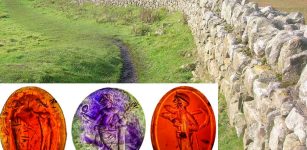 Amazing 2,000-Year-Old Engraved Roman Gems Discovered Near Hadrian’s Wall
Archaeology | Jan 30, 2023
Amazing 2,000-Year-Old Engraved Roman Gems Discovered Near Hadrian’s Wall
Archaeology | Jan 30, 2023 -
 The Norns – Shapers Of Destiny Who Recorded Days In Person’s Life In Norse Mythology
Featured Stories | May 18, 2020
The Norns – Shapers Of Destiny Who Recorded Days In Person’s Life In Norse Mythology
Featured Stories | May 18, 2020 -
 ‘Sensational’ Discovery Of Large Untouched 4,000-Year-Old Grave In Norway
Archaeology | Nov 10, 2023
‘Sensational’ Discovery Of Large Untouched 4,000-Year-Old Grave In Norway
Archaeology | Nov 10, 2023 -
 2,000-Year-Old Stringed Instrument Found In Vietnam
Archaeology | Feb 22, 2023
2,000-Year-Old Stringed Instrument Found In Vietnam
Archaeology | Feb 22, 2023 -
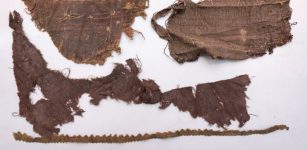 Unique Well-Preserved 16th-17th Century Fabrics And Shoes Found In Toruń, Poland
Archaeology | May 13, 2024
Unique Well-Preserved 16th-17th Century Fabrics And Shoes Found In Toruń, Poland
Archaeology | May 13, 2024 -
 Medieval Friars Were ‘Riddled With Parasites,’ Study Finds
Archaeology | Aug 19, 2022
Medieval Friars Were ‘Riddled With Parasites,’ Study Finds
Archaeology | Aug 19, 2022 -
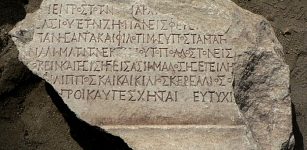 2nd Century Inscription Unearthed At Forum Of Ancient City Of Philippopolis, Bulgaria
Archaeology | Oct 21, 2019
2nd Century Inscription Unearthed At Forum Of Ancient City Of Philippopolis, Bulgaria
Archaeology | Oct 21, 2019 -
 DNA Research Shows Ancient Britain Was More Diverse Than We Imagined
Featured Stories | Nov 4, 2022
DNA Research Shows Ancient Britain Was More Diverse Than We Imagined
Featured Stories | Nov 4, 2022 -
 What Was On The Menu For Stonehenge’s Builders, 2500 BC? Milk, Yoghurt And Cheese Only Eaten In Exclusive Ceremonies
Archaeology | Oct 14, 2015
What Was On The Menu For Stonehenge’s Builders, 2500 BC? Milk, Yoghurt And Cheese Only Eaten In Exclusive Ceremonies
Archaeology | Oct 14, 2015 -
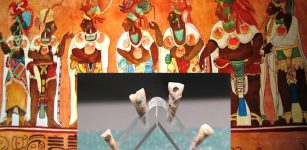 Ancient Maya Used An Unknown And Ingenious Method To Prevent Tooth Decay And Infections – Scientists Say
Archaeology | May 24, 2022
Ancient Maya Used An Unknown And Ingenious Method To Prevent Tooth Decay And Infections – Scientists Say
Archaeology | May 24, 2022 -
 Death And Afterlife In Sumerian Beliefs
Civilizations | May 12, 2017
Death And Afterlife In Sumerian Beliefs
Civilizations | May 12, 2017 -
 Archaeologists Focus On Greek Poet Aratus’ Memorial Tomb And Ruins Of Soli Pompeiopolis
Archaeology | Aug 12, 2020
Archaeologists Focus On Greek Poet Aratus’ Memorial Tomb And Ruins Of Soli Pompeiopolis
Archaeology | Aug 12, 2020 -
 New Inscriptions, Gold And Paint Showed Thanks To Restoration In Temple Of Edfu
Archaeology | Sep 20, 2024
New Inscriptions, Gold And Paint Showed Thanks To Restoration In Temple Of Edfu
Archaeology | Sep 20, 2024 -
 Tailteann Games: Ancient Irish Version Of The Olympic Games
Ancient History Facts | May 15, 2016
Tailteann Games: Ancient Irish Version Of The Olympic Games
Ancient History Facts | May 15, 2016 -
 170-Million-Year-Old Sea Monster Identified As The Oldest Mega-Predatory Pliosaur
Evolution | Oct 23, 2023
170-Million-Year-Old Sea Monster Identified As The Oldest Mega-Predatory Pliosaur
Evolution | Oct 23, 2023 -
 Major Earthquake Struck The Atacama Desert 3,800 Years Ago, Forcing Hunter-Gatherers To Move Inland
Archaeology | Apr 7, 2022
Major Earthquake Struck The Atacama Desert 3,800 Years Ago, Forcing Hunter-Gatherers To Move Inland
Archaeology | Apr 7, 2022 -
 Early Humans Were Probably Driven To Extinction By Climate Change- Study Suggests
Civilizations | Oct 15, 2020
Early Humans Were Probably Driven To Extinction By Climate Change- Study Suggests
Civilizations | Oct 15, 2020 -
 Mysterious Ancient Andean Waskiri Structure Built For Unknown Purpose Investigated By Scientists
Archaeology | Apr 14, 2023
Mysterious Ancient Andean Waskiri Structure Built For Unknown Purpose Investigated By Scientists
Archaeology | Apr 14, 2023 -
 Kobold: Mythological Spirit Of Underground: Guardian Of Miners And Earth’s Treasures
Featured Stories | Jun 13, 2016
Kobold: Mythological Spirit Of Underground: Guardian Of Miners And Earth’s Treasures
Featured Stories | Jun 13, 2016

